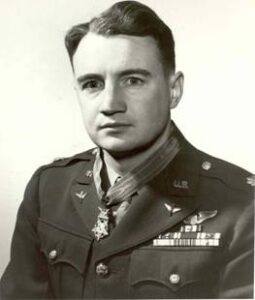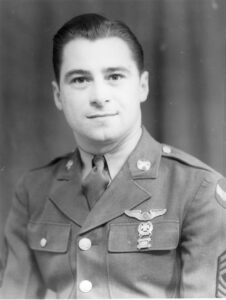by Tom Clavin
On July 25, 1918, Jay Zeamer was born. Zeamer is the main character of Lucky 666, a gripping World War II story written by Bob Drury and yours truly. His birthday is the same day as mine, but we’re many years apart: Were he still alive, Zeamer would be turning 105. But it does provide an opportunity to tell some of his story, especially an event that took place 80 years ago.

Zeamer was born in Pennsylvania but grew up in Orange, New Jersey, with his family spending summers in Boothbay Harbor, Maine. He was a bright student, an Eagle Scout, and he enjoyed tinkering with machines. As a teenager, he built his own boat that he took on long sails and he rebuilt a car that he drove back and forth to the Culver Academy in Indiana and later to MIT in Massachusetts. When World War II began in Europe, Zeamer joined the Army. What he most wanted to do was become a pilot in the Army Air Corps. As a lieutenant, he trained at Langley Field in Virginia where he met and became good friends with a bombardier, Sgt. Joe Sarnoski.
Though Sarnoski had also been born in Pennsylvania, he and Zeamer came from much different backgrounds. Joe was one of 16 Sarnoski siblings in a family that scraped out a living in coal country. In 1936, when his younger brothers were old enough to take over the routine chores at home, Joe joined the Army. By the time he met Jay Zeamer, he was an experienced instructor hoping to be sent overseas—especially after the Japanese bombed Pearl Harbor.
The two men did get shipped off to Australia, arriving at different times in 1942. The situation there was very precarious because the Japanese had occupied most of the southwest Pacific. The beleaguered American, British, and Australian forces had their backs to the wall as the Japanese made plans to gobble up the rest of the region. The Jimmy Doolittle raid on Tokyo and victory in the Battle of Midway offered rays of hope that the army and navy of the Rising Sun were not invincible. Another positive sign was the arrival of B-17s bombers, which with increasing efficiency were rolling off the Boeing assembly line back in the States.
The Flying Fortress, with its ability to fly long distances to deliver destructive payloads as well as its durability, became a powerful weapon in the Pacific Theater. By the time Jay Zeamer and Joe Sarnoski were reunited at the Allied base in New Guinea in late 1942, Jay was a B-17 pilot and Joe was an experienced bombardier. Though Jay was a skilled airman, he wasn’t the most popular pilot among his superior officers because he was something of a renegade, creating his own flight plans and taking too many risks. He found himself “benched,” looking for a plane to fly.
Jay was not one to sit idly and wait for something to happen. With Joe, he recruited a crew of so-called misfits—guys other captains were glad to give away—and then found a B-17 discarded as too damaged to fly again. The nine men, who would earn the name “Eager Beavers” because there was no job or mission they wouldn’t tackle, set to work rebuilding the plane. It was dubbed “Old 666” because those were the last three serial numbers on the tail. By the spring of 1943, with Jay piloting and Joe the bombardier, Old 666 was in the air and attacking Japanese positions. During one of the missions, Jay earned his second Silver Star by using the Flying Fortress like a fighter plane and strafing anti-aircraft guns that were knocking other B-17s out of the sky.

That June, the Allied brass had determined that the key to taking the Solomon Islands, and thus inflicting a major loss on the enemy, was the invasion and occupation of Bougainville. But they knew little about the island, including how heavily fortified it was and where the best location was for the Marines to go ashore. The only way to gain crucial intel was to send a lone B-17 the 600 miles to Bougainville to photograph it. Actually, the 600 miles east would not be enough, because if the bomber did not return with the film, the mission was a waste of men and resources. Clearly, this was close to being a suicide mission, and the top brass could not order a crew to undertake it.
As soon as Jay and the Eager Beavers heard about the mission, they volunteered. They not only believed that by now they were the best crew in the 43rd Group but when they rebuilt their B-17 they had armed it with 19 .50-caliber machine guns, so it was the most powerful fighting bomber in the southwest Pacific. At 4 a.m. on June 16, 1943, Old 666 took off.
I don’t want to give away the whole story (Lucky 666 is available in both paperback and eBook). Old 666 did return. However, not every member of the crew made it back alive. That day in June 1943 saw the longest dogfight in military aviation history, and with two Medals of Honor (one of them posthumous) and other awards, Jay and Joe and the rest of the Eager Beavers became the most decorated American crew of the war. They completed their mission. A few months later came the successful invasion of Bougainville by U.S. Marines and the tide of the war turned in favor of the Allies.
Originally published on Tom Clavin’s The Overlook.

Tom Clavin is a #1 New York Times bestselling author and has worked as a newspaper editor, magazine writer, TV and radio commentator, and a reporter for The New York Times. He has received awards from the Society of Professional Journalists, Marine Corps Heritage Foundation, and National Newspaper Association. His books include the bestselling Frontier Lawmen trilogy—Wild Bill, Dodge City, and Tombstone—and Blood and Treasure with Bob Drury. He lives in Sag Harbor, NY.
